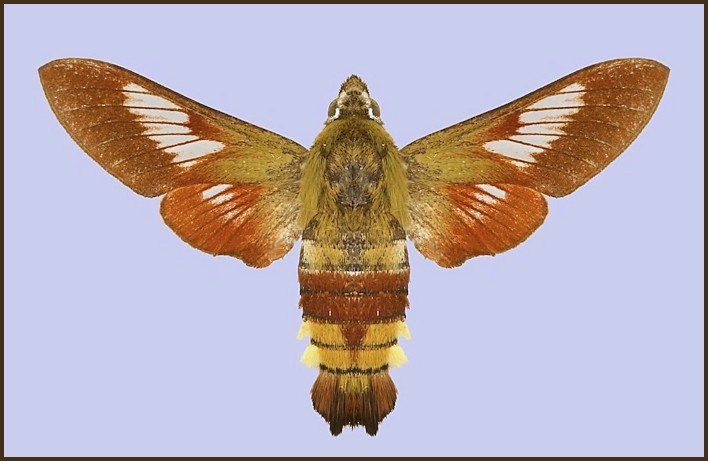UK: Anatolian Bee Hawkmoth
Macroglossa ducalis var. dentata Staudinger, 1887, Stettin. ent. Ztg 48: 66.Type locality: Aintab near Antiochia [Gaziantep, near Hatay, Turkey; however, the specimen label specifies 'Gjaurdagh' as the collection locality, which are the present-day Nur Daglari hills (Amanos Mountains) just north of Hatay].
(Taxonomic notes. (i) The descriptions and illustrations provided by Daniel (1932; 1939) of the Turkish Hemaris fuciformis subsp. syra (Daniel, 1939), (Mitt. münch. ent. Ges. 29: 94), initially indicated that it could be a form of Hemaris dentata (Staudinger, 1887). However, Daniel (1932) was of the opinion that it was closer to Hemaris fuciformis (Linnaeus, 1758), although the colour of the thorax and abdomen reminded him more of Hemaris croatica (Esper, 1800). Danner, Eitschberger & Surholt (1998) treated Hemaris syra as a good species, although they were uncertain of its exact status. Kitching & Cadiou (2000) compared Hemaris syra, Hemaris fuciformis and Hemaris dentata from Turkey and concluded that Hemaris syra probably represented the opposite sex of the sexually dimorphic Hemaris dentata. With the capture of further specimens of both Hemaris syra and Hemaris dentata it has become clear that Hemaris syra is not conspecific with Hemaris dentata -- they are two distinct but related species.
(ii) For very good reasons, Hemaris dentata was originally described as a subspecies of Hemaris ducalis (Staudinger, 1887) -- adult morphology, behaviour and habitat preferences are similar. However, recent DNA barcoding studies have confirmed that Hemaris dentata is close to Hemaris syra, and that both are related to Hemaris fuciformis.
(iii) De Freina (1988) was of the opinion that this taxon represented a natural hybrid between Hemaris fuciformis (= Hemaris syra in southern Turkey) and Hemaris croatica; this was discussed further in De Freina (2012). The two overlap in range where Hemaris dentata is to be found.)
Holarctic; western Palaearctic region. Pleistocene refuge: Monocentric -- Pontomediterranean subsection of the Mediterranean refuge.


Wingspan: 36--45mm. Intermediate in colour between Hemaris fuciformis and Hemaris croatica, but with male genitalia more closely resembling those of the former. Forewing cell undivided. A variable species, with the hyaline areas very reduced or absent (i.e. completely scaled over) in some individuals (a characteristic feature of Hemaris ducalis). The abdominal pattern may approach that of Hemaris fuciformis (de Freina, 1988). However, a unique feature of Hemaris dentata are the two dark tufts which protrude rearwards out of the centre of the reddish anal brush.
Care should be taken when identifying live individuals of this species in the field in southern Turkey as it closely resembles Hemaris syra (Daniel, 1939).



Diurnal. A very local species, with one or two specimens turning up here and there in flower-rich mountain meadows inbetween forest fragments at between 1000 and 2300m. Very similar in behaviour to Hemaris fuciformis.
With the capture of further specimens it appears that this species was/is a denizen of the damper areas of pine (Pinus) and cedar (Cedrus) forests which used to occur along the mountains of southern Turkey and into Syria. The local nature of Hemaris dentata may be the result of the destruction and fragmentation of these forests. Overgrazing of the understory shrubs in the remaining fragments has compounded the problem, along with drought and groundwater extraction.


Univoltine; June to late July. The last two weeks of July at 1400--1700m (de Freina, 1988).
OVUM:

LARVA: Full-fed 33--42mm. The fully-grown larva resembles that of Hemaris ducalis (Serge Yevdoshenko, pers. comm. 2024).






Hostplants. Shrubby Lonicera growing as an understorey shrub in open conifer woodland (Serge Yevdoshenko, pers. comm. 2024). Damper areas near a source of groundwater are preferred.
PUPA: 37mm. Blackish brown, rugose, slightly glossy, very similar to that of Hemaris croatica (Esper, 1800), and formed in a soil/debris cell lined with silk strands. The overwintering stage (Serge Yevdoshenko, pers. comm. 2024).

Unknown.
Southern Turkey (de Freina, 2012; Koçak & Kemal, 2018) as far west as Davras Dagi (near Isparta) in the western Toros Mountains. Other confirmed localities in Turkey are the Nur Daglari/Amanos Mountains (near Hatay), Ala Daglari (near Nigde, 1650m) and Anamas Daglari (near Egridir, 1500m) (de Freina, 1988), as well as Sihli (near Tekir, 1300-1700m), Palaz Dagi (near Antalya, 1300m), Ilica (near Suleymanli), Nemrut Dagi (near Adiyaman, 1500-2100m) and Harput (near Elazig, 1200m) (W. Hogenes, pers. comm.). Records from 'Syria' (Rothschild & Jordan, 1903) refer to what is now southern Turkey.
Extra-limital range. None.
 Return to species list
Return to species list